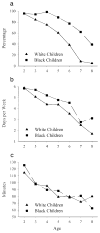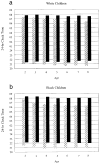Racial differences in reported napping and nocturnal sleep in 2- to 8-year-old children
- PMID: 15866856
- PMCID: PMC2987587
- DOI: 10.1542/peds.2004-0815D
Racial differences in reported napping and nocturnal sleep in 2- to 8-year-old children
Abstract
Objectives: The objectives of this study were to examine racial differences in reported napping and nighttime sleep of 2- to 8-year-old children, to identify factors accounting for these differences, and to determine if variability in napping was related to psychosocial functioning.
Methods: Caretakers of 1043 children (73.5% non-Hispanic white; 50.4% male) 2 to 8 years old from a community sample reported on their children's napping behavior and nighttime sleep. Caretakers of 255 preschool children (3-5 years old) also completed the Behavior Assessment System for Children.
Results: A more gradual age-related decline in napping was found for black children. At age 8, 39.1% of black children were reported to nap, compared with only 4.9% of white children. Black children also napped significantly more days per week, had shorter average nocturnal sleep durations, and slept significantly less on weekdays than on weekend nights. Despite differences in sleep distribution, total weekly sleep duration (diurnal and nocturnal) was nearly identical for the 2 racial groups at each year of age. Logistic regression analysis revealed that demographic variables were related to but did not fully explain napping differences. Napping in a subset of preschoolers was not significantly related to psychosocial functioning.
Conclusions: There are remarkable racial differences in reported napping and nighttime sleep patterns beginning as early as age 3 and extending to at least 8 years of age. These differences are independent of commonly investigated demographic factors. Differences in napping behavior do not seem to have psychosocial significance in a sample of preschool children.
Conflict of interest statement
No conflict of interest declared.
Figures



 ) and weekend (■) bedtimes and wake times for 2- to 8-year-old children.
) and weekend (■) bedtimes and wake times for 2- to 8-year-old children.References
-
- Wolfson AR. Sleeping patterns of children and adolescents: developmental trends, disruptions, and adaptations. Child Adolesc Psychiatr Clin N Am. 1996;5:549–568.
-
- Sheldon SH, Spire J, Levy HB. Pediatric Sleep Medicine. Philadelphia, PA: Harcourt Brace Jovanovich, Inc; 1992.
-
- Anders TF, Sadeh A, Appareddy V. Normal sleep in neonates and children. In: Ferber R, Kryger M, editors. Principles and Practice of Sleep Medicine in the Child. Philadelphia, PA: W. B. Saunders; 1995. pp. 7–18.
-
- Weissbluth M. Naps in children: 6 months-7 years. Sleep. 1995;18:82–87. - PubMed
-
- Iglowstein I, Jenni OG, Molinari L, Largo RH. Sleep duration from infancy to adolescence: reference values and generational trends. Pediatrics. 2003;111:302–307. - PubMed
Publication types
MeSH terms
Grants and funding
LinkOut - more resources
Full Text Sources
Research Materials

